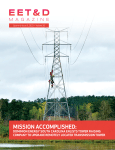The world avidly discusses grid modernization as electric vehicles (EVs) and the renewable energy boon wash over the planet. Those technologies are advancing faster than the grid, but humans need the grid to power them. All nations will have the same issue — coming up with the time, finances and resources to update their current grid or install a new, expensive high-tech utility grid that can power these equally costly technologies.
Microgrids could solve these woes by providing solutions in an accessible format. Since microgrids are on a smaller scale, it’s easier to determine energy needs and how well-connected technologies perform. But are these microgrids the answer, or will nations still need to undergo total grid modernization for a sustainable planet?
How do microgrids empower communities: The pros
Microgrids are one of the most recent solutions to help the world avoid a complete grid overhaul. They serve a community or building ecosystems, like a hospital or college campus, providing clean energy on or off the more comprehensive national or macrogrid, with a wide scale of wattages.
Many organizations believe microgrids are an ideal solution. They’re easier to implement than larger grids and could save connected buildings 20%-30% in electricity costs, as proven by microgrid tests in Australia. The possibilities are vast.
AI integration
Microgrids become increasingly relevant when scaling alongside other budding technologies, like AI and machine learning. Compatibility with these forces increases the long-term value of microgrids, especially for researchers attempting to streamline and optimize manufacturing, implementation and engineering processes.
Studies explain the most useful ways to incorporate AI into a microgrid, especially during times of struggle:
- Optimization
- Load forecasting
- Stability assessment
- Defect detection
- Alerts for security challenges
Machine learning (ML) can learn enough about the usage habits of a community to execute predictive analytics, project future financial burdens, operational excellence during a disaster and energy expenditure based on supply and demand.
Scalability
Raw materials are in short supply worldwide in every sector. Citizens are often blissfully unaware of how much energy they use during natural disasters, sapping resources from the grid for comfortability. Installing microgrids a little at a time will quell the daunting feeling of doing the whole grid simultaneously. Only 0.2% of the U.S. is currently on a microgrid, extending over seven states — but microgrid usage could exceed current trajectories if regulatory bodies become aware of their benefits.
Instead, smaller projects can compound over time — mainly when renewable technologies rely on environmentally intensive metals like nickel which account for 90% of EV batteries. Installing a few microgrids at a time puts less stress on the planet as researchers discover less damaging ways to execute eco-friendly objectives.
The most enticing scalability boon arrives when looking at price. Microgrids are inevitably cheaper than national digital transformation. Incorporating thousands of microgrids will add up, but they can hit neighborhoods little by little with smart financial planning.
Grid relief
Implementing high-octane technologies like EV chargers and massive renewable infrastructure is weighing down the antiquated grid. Taking some of these electronics off its back will allow it to perform efficiently to everything it’s connected to. Grid congestion is a growing concern among governments and utility providers, and they struggle to find consistent, reliable solutions for curbing it. It means fewer outages caused by stress or entities abusing it by pulling unfair amounts of power.
Microgrids also provide relief in another way — emergency care access. If the macrogrid suffers from outside influences, causing outages on a large scale, emergency services could struggle to repair and restore it. While microgrids may need extra care, a different category of responders can assist with isolated microgrids. They’ll find solutions faster, freeing resources for those helping the old grid and increasing the speed people can obtain access again.
Promotes regulatory change
If governments are not taking the initiative to instigate legislation concerning microgrids, the people must make them aware it’s a critical concern. Many places are still unsure of what a microgrid constitutes, needing governmental bodies to define what microgrids can and can’t do. Providers and users of microgrids need formalization of responsibilities and clarity with contracts with standardized language. Nothing is better for motivating federal action than adoption, particularly when microcommunities vocalize how microgrids improve their livelihoods.
Communities worldwide are looking to adopt a microgrid in their community, and the more that appear, the greater incentive federal governments must regulate it and find a way to optimize it for economic betterment.
Microgrids will inevitably collect data, especially with other technological compatibility. Not only will governments have to define and invest in microgrids, but they will also have to create legislation surrounding its related subject matters, like data privacy and collection. Lawmakers resist legislation around these issues because they’re novel, and humanity doesn’t have all the answers for what’s best, ethical or within a government’s control. It has to happen soon, and microgrids stoke that fire.
Environmental wellness
Another apparent benefit of microgrids is that they help parts of the world become more eco-conscious and reliant upon clean energy instead of fossil fuels. It can make a community zero-emissions and energy independent. Regarding environmentalism, it’s best to implement some changes immediately instead of waiting for a complete overhaul potentially decades later. So, why not start now?
It also promotes environmental well-being by capturing residual energy from existing power plants, whether fossil fuel-based or not and can reallocate that energy into a microgrid. Transmission lines are notorious for the amount of power they waste. For example, captured hydrogen from a natural gas plant could funnel into microgrids like energy from solar storage or reclaimed nuclear waste.
Why the drawbacks of microgrids turn heads: The cons
While microgrids have clear advantages, it’s far from a perfect system. Numerous drawbacks prevent it from obtaining widespread adoption that experts attempt to respond to with research and development — but it’s all still underway.
Cyberattack vulnerability
Critical infrastructure is one of the most vulnerable targets for hackers. Since IoT-connected devices and data-driven companies collect as much as possible, everything from utilities to government offices has precious and priceless data hackers want to exploit. Damaging or disrupting critical infrastructure is one of the best ways to cause a wide-scale distraction to compromise their desires.
It’s crucial to note microgrids are safer but still accessible to hackers compared to a comprehensive grid. Segmenting and fragmenting the system will put fewer people in harm’s way, but it doesn’t mean they still aren’t at risk. Every electronic device is susceptible to cybercriminal whims, and utility providers and microgrids are no exception, regardless of their defensive efforts.
Lack of control
Cyberattacks could shut off critical infrastructure, but so can a bad storm. The age of the current utility grid is showing as outages and disruptions are more frequent every week. Though microgrids have increased resilience against these influences because they’re smaller and sometimes independent of the national grid, they’re still at risk of cyberattacks or natural disasters.
These factors that would impact microgrids the most, causing distress in related communities, are primarily outside human control. Defending against cyberattacks is one thing, but defending against erratic weather patterns is different.
Investor tensions
Numerous stakeholders give countless dollars to utility companies, making microgrids a direct challenge to their financial wealth. With most old-time investors nestled into fossil fuels, the major players that have made the utility industry successful are unlikely to transition to microgrid investments. If they did, mixed ownership could bring unnecessary politics into the sector as public-private partnerships skew priorities, especially if businesses attempt to sync everything back to the macrogrid.
The stubbornness could harm progress, especially when renewable energy needs private and federal support to keep momentum to achieve global goals. Investors are already upset about how little say they maintain in how entities deploy microgrids, arrays or battery storage and how that impacts their funds. These frustrations can build until they affect attempts at passing federal regulations.
Specialized equipment
Microgrids are streamlined once implemented. However, operating them requires special software and operators. The setup is more complex than connecting a neighborhood to some solar panels. A microgrid can consist of the following:
- Other controllable energy generation, like hydrogen fuel cells
- Backup generators
- Energy storage
- Non-controllable generation, such as other weather-reliant renewables like wind power
- Coupling points to connect distribution
- Grid management hub
- Uninterruptible power supplies (UPSs)
These backend necessities are more labor-intensive than a homeowner putting some fuel in a classic generator. Ultimately, performing a boot-up of a microgrid during a disaster will require configuration to battery stores and data. The need for green skills is rising, meaning people will be qualified to operate and maintain these technologies in the coming years. Even if the controllers are reliable, many question if it’s genuinely more straightforward than having an old-fashioned generator.
Will the pros or cons win?
There is uncertainty about how likely people will adopt microgrids. They could solve numerous environmental issues while providing consistent, clean energy access. Communities want the energy independence and autonomy associated with microgrids, but in the back of everyone’s minds lies practical sustainability concerns and the potential for cyberattacks.
When regulatory bodies and advocates combine their knowledge and motivations, they can align their goals to fit the needs of the many to incorporate more microgrids when it’s helpful and other eco-conscious initiatives where it may not be the best option.

Ellie Gabel is a writer based in Raleigh, NC. She primarily writes about environmental issues and innovative technology, and she works as an associate editor for Revolutionized.







